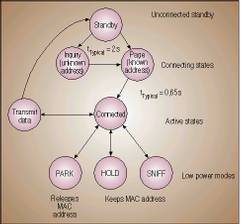
In 1998 a group was formed by representatives from Ericsson, IBM, Intel, Nokia, Toshiba, 3com, Lucent, Microsoft and Motorola. The intent was to create an open specification (ie a global industry standard) for a short-range, cable replacement, radio technology for wireless connectivity. This group became known as the Bluetooth Special Interest Group (SIG). These are leaders in the telecommunications and computing industries that are driving development of the technology and bringing it to market.
What's it all about
Bluetooth is the code name for a technology specification for small form factor, low-cost, short range radio links between mobile PCs, mobile phones and other portable devices. It answers the need for short-range wireless connectivity within three areas:
* Bluetooth is a system solution comprising hardware, software and interoperability requirements.
* Bluetooth specifications specify the complete system.
* Bluetooth operates in a globally available 2,4 GHz ISM band, ensuring worldwide communication compatibility.
Bluetooth technology
Bluetooth technology allows for the replacement of the many proprietary cables that connect one device to another with one universal short-range radio link. For instance, Bluetooth radio technology built into both the cellular telephone and the laptop would replace the cumbersome cable used today to connect a laptop to a cellular telephone. Printers, PDAs, desktops, fax machines, keyboards, joysticks and virtually any other digital device can be part of the Bluetooth system.
But beyond untethering devices by replacing the cables, Bluetooth radio technology provides a universal bridge to existing data networks, a peripheral interface, and a mechanism to form small private ad hoc groupings of connected devices away from fixed network infrastructures. See Figure 1.
Designed to operate in a noisy radio frequency environment, the Bluetooth radio uses a fast acknowledgement and frequency hopping scheme to make the link robust. Bluetooth radio modules avoid interference from other signals by hopping to a new frequency after transmitting or receiving a packet.
Compared with other systems operating in the same frequency band, the Bluetooth radio typically hops faster and uses shorter packets. This makes the Bluetooth radio more robust than other systems. Short packages and fast hopping also limit the impact of domestic and professional microwave ovens. Use of Forward Error Correction (FEC) limits the impact of random noise on long-distance links. The encoding is optimised for an uncoordinated environment.

Bluetooth radios
Bluetooth radios operate in the unlicensed ISM band at 2,4 GHz. A frequency hop transceiver is applied to combat interference and fading. A shaped, binary FM modulation is applied to minimise transceiver complexity. The gross data rate is 1Mbps. A Time-Division Duplex scheme is used for full-duplex transmission.
The Bluetooth baseband protocol is a combination of circuit and packet switching. Slots can be reserved for synchronous packets. Each packet is transmitted in a different hop frequency. A packet nominally covers a single slot, but can be extended to cover up to five slots.
Bluetooth can support an asynchronous data channel, up to three simultaneous synchronous voice channels, or a channel which simultaneously supports asynchronous data and synchronous voice. Each voice channel supports 64 kbps synchronous (voice) link. The asynchronous channel can support an asymmetric link of maximally 721 kbps in either direction while permitting 57,6 kbps in the return direction, or a 432,6 kbps symmetric link.

The Bluetooth air interface is based on a nominal antenna power of 0 dBm. The air interface complies with the FCC rules for the ISM band at power levels up to 0 dBm. Spectrum spreading has been added to facilitate optional operation at power levels up to 100 mW worldwide. Spectrum spreading is accomplished by frequency hopping in 79 hops displaced by 1 MHz, starting at 2,402 GHz and stopping at 2,480 GHz.
Due to local regulations the bandwidth is reduced in Japan, France and Spain. This is handled by an internal software switch. The maximum frequency hopping rate is 1600 hops/s. The nominal link range is 10 cm to 10 m, but can be extended to more than 100 m by increasing the transmit power. (See Figure 1.)
Network topology - The Bluetooth system supports both point-to-point and point-to-multipoint connections. Several Piconets can be established and linked together ad hoc, where each Piconet is identified by a different frequency hopping sequence. All users participating on the same Piconet are synchronised to this hopping sequence. The topology can best be described as a multiple Piconet structure. See Figure 2.
The full-duplex data rate within a multiple Piconet structure with 10 fully-loaded, independent Piconets is more than 6 Mbps. This is due to a data throughput reduction rate of less than 10% according to system simulations based on 0 dBm transmitting power (at the antenna).
Voice - Voice channels use the Continuous Variable Slope Delta Modulation (CVSD) voice coding scheme, and never retransmit voice packets. The CVSD method was chosen for its robustness in handling dropped and damaged voice samples. Rising interference levels are experienced as increased background noise: even at bit error rates up 4%, the CVSD coded voice is quite audible.
Bluetooth agreements
Since the formation of Bluetooth SIG, 1371 companies have signed the Bluetooth Adopter Agreements and joined the Bluetooth SIG. The Adopters are all supportive of the technology and committed to developing Bluetooth products. By signing zero-cost agreements, member companies qualify for a royalty-free licence to build products based on the Bluetooth technology, as well as to access the Bluetooth specification and intensive training seminars. Additionally, the Bluetooth SIG provides a forum for vendor interaction and co-development opportunities.
Source: www.bluetooth.net

© Technews Publishing (Pty) Ltd | All Rights Reserved